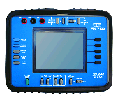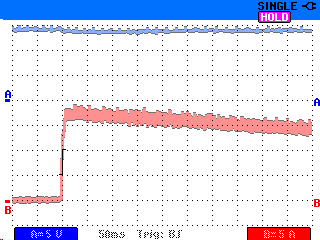Scope - Amp Probe Setup
Click on your scope for detailed instructions
to setup your scope for use with an amp probe.
If your scope is not listed select Analog Scopes / Generic DSO.
Fluke 98 Series II
Snap-on Vantage PGM
Interro PDA / OTC Vision / Matco Insight
LS-2000 / ADL-7100
Analog Scopes / Generic DSO
Amp Probe Training Video
Just starting out current ramping? Don't forget about voltage testing…..
Voltage tests easily expose voltage drops that can be caused by excessive resistance or excessive current. These dynamics can often be hard to determine in a current waveform especially if you do not have detailed specs for the current level.
To see this for yourself test a radiator fan motor. Most will show some level of voltage dropping as the waveform below. At what point is it a problem?
Current, Voltage and Circuit Energy
Another value to voltage testing along with current testing is that it provides a more complete picture of the energy the circuit is using. Mathematically, the energy of the circuit is calculated (voltage x current).
The voltage waveform qualifies the current waveform. Consider this: If the current waveform measures 6 amps and the voltage is at 6 volts that is only 36 watts of energy. 6 amps at 12 volts is 72 watts.
This can be extremely important when dealing with electrical motors such as fuel pumps. For example, an electrical motor can spin slowly due to some mechanical problem or due to a low circuit voltage. When the motor spins slow there is more time that any pair of brushes / commutator bars make contact allowing more current to flow! If you are testing for a specific current level it should be qualified by doing a voltage test.
A voltage test qualifies the circuit and the voltage source integrity.
Qualify
There will be times that the waveform does not look as you would expect or is simply unfamiliar. For most circuits there are other ways to qualify and those other methods should always be considered. For example, a current waveform of a new fuel pump can look bad but the pump can still be doing its job. The waveform looks bad because the new brushes have not had time to seat in. The lesson learned is that the final qualifier is fuel pressure and volume - not the current waveform!Ask yourself:
Ultimately, what is this circuit suppose to be doing and can I relate what it is doing to what I see on the scope screen?
Keep in Mind
Keep in mind that a current waveform is just a step in the process. Sometimes it is enough to determine good or bad. Sometimes it is not. When it is not, qualify with voltage and with what you hear, see, and sometimes smell and feel. And don't forget the traditional tests when applicable.






